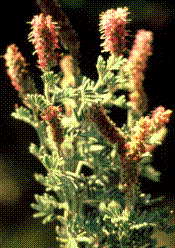
Silky Prairie Clover (Dalea villosa)
Central and eastern North Dakota are home to silky prairie clover. The species ranges from Saskatchewan and Manitoba south to western Wisconsin, Texas, and New Mexico at elevations to 6,000 ft.
Silky prairie clover is perennial from red-orange roots and a branching caudex that bears one to several stems up to 20 inches tall. Leaves and stems are covered with silky tan hairs. Leaves are alternate and pinnate, like two combs held back-to-back. Each leaf is about an inch long and bears 11-21 narrow leaflets. About 50 to a hundred or more tiny bright purple (sometimes rose, pink, or white) flowers are crowded into spikes up to 4 inches long. These spikes are on the upper half of the plant and more numerous at the top. At maturity, tiny fruits (legumes) contain smooth brown seeds.
Look for silky prairie clover during July and August on sandy native prairie that is not heavily grazed by livestock. The Kiowa used some Daleas with tough, slender stems, tipped with cactus thorns, to make small game arrows. Other Daleas in the western United States were used to dye skins and for teas taken for coughs and colds, but I could find no references to such uses for the species discussed here.
Daleas are members of the economically important bean family (Fabaceae). Fab means "bean" in Latin. The family includes our alfalfas, peas, clovers, peanuts, and trees such as caragana and locust. The genus was named in honor of the distinguished English botanist Samuel Dale (1659-1739). There are about 200 species of Dalea, mostly found in Mexico and the southwestern United States. The specific epithet villosa means "shaggy with fairly long, soft, straight, non-interwoven hairs" in botanical Latin. Silky prairie clover was first described for science in 1818 under the genus Petalostemon by the famous naturalist, botanist, and ornithologist, Thomas Nuttall (1786-1859). Nuttall visited the Mandan villages in what is now North Dakota in 1810-1811.
![]()
 Wildflower
Seed For Sale
Wildflower
Seed For Sale